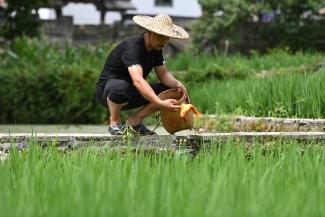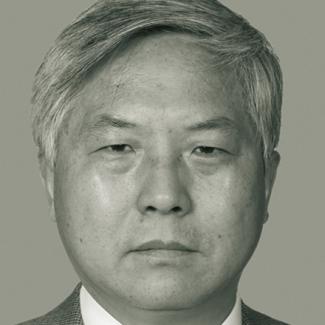Traditional agriculture
Traditional agricultural ecosystems harbour remarkable biodiversity
 picture-alliance/Xinhua News Agency/Huang Zongzhi
Farmer releases fish into a rice field in Qingtian County, China.
picture-alliance/Xinhua News Agency/Huang Zongzhi
Farmer releases fish into a rice field in Qingtian County, China.
In rural China, farmers still employ the traditional practice of cultivating rice on flooded terraces while simultaneously raising fish in the water. Such unique forms of land use have evolved over centuries, harmonising with nature. The wisdom passed down through generations has resulted in sustainable ecosystems, enabling local communities to feed themselves while also preserving natural resources.
The United Nations Food and Agriculture Organization (FAO) recognises such unique ecosystems by designating them Globally Important Agricultural Heritage Systems (GIAHS). China boasts 19 out of the 74 GIAHS worldwide as of June 2023. Qingtian county in Zhejiang Province is known for its traditional rice-fish culture, while other GIAHS in China include a mountainous region, also in Zhejiang, where mushroom cultivation coexists with sustainable agroforestry, and the city of Fuzhou with its jasmine and tea culture system.
GIAHS are complex systems with interconnected components working together. They exhibit remarkable agrobiodiversity, which is defined by the FAO as the variety of animals, plants and microorganisms that are used directly or indirectly for food and agriculture, including crops, livestock, forestry and fisheries.
A key aspect of GIAHS is the presence of different types of diversity, namely:
- agri-species diversity,
- agroecosystem and landscape diversity and
- agricultural diversity.
Biodiversity strengthens ecosystems
There are several ways to enhance agri-species diversity. One method is mixed cropping, where different crops are grown together in the same field. Another approach is intercropping, where a crop is planted immediately after another crop is harvested in the same field (Zhang et al., 2016). Introducing other species is an option too. For example, as mentioned above, rice fields can be enriched with fish and, in some cases, ducks as well.
Positive interactions can arise when different species utilise available resources in their unique ways. For example, rice plants provide both nourishment and shade to fish. In return, the fish consume pests, enhance the soil and fertilise the plants through their waste.
Increased biodiversity can therefore enhance ecosystem functions, productivity and stability. A study conducted in Zhejiang found that rice yields in rice-fish culture were significantly higher than in rice monoculture without fish. This improvement was achieved without the use of pesticides. Additionally, the presence of fish minimised weed and pest populations (Xie et al., 2011). Other studies have arrived at similar results.
Agroecosystem and landscape diversity
In various GIAHS locations, distinctive agricultural landscapes have developed as a result of the dynamic interplay between humans and nature. They can consist of forests, grasslands or farmlands and can also be influenced by rivers and lakes. Moreover, the homes of the local residents who have contributed to the formation of these areas over extended periods, are an integral part of these landscapes.
One example of resourceful land management can be found in northern China’s mountainous region of Shexian. Throughout the centuries, residents constructed large-scale dryland terraces on steep hillsides. These structures allow them to optimise the use of limited water and soil resources. On these terraces, they grow a variety of crops such as Chinese prickly ash, walnuts, millet and corn. The resulting cultivated landscape is a mixture of stone terraces, forests, shrubs, waterways and communities in the valley. The individual components are closely interconnected and coexist harmoniously.
Agri-cultural diversity
Biodiversity is also closely connected to cultural diversity. In areas designated as GIAHS, local residents have adapted to their natural environment over long periods of time. The rich experiences of various ethnic groups are evident in their unique cultures, which form a significant aspect of GIAHS. In southern China, for example, the Dong people keep not only fish in their rice fields, but also ducks. This diversity in agriculture is tightly interwoven with their traditional culture, encompassing aspects such as diet, clothing, architecture and medicine. Additionally, immaterial aspects like religion, traditions and locally applied rules play a role in preserving agricultural diversity (Min et al., 2008, Zhang et al., 2016).
Protecting valuable agricultural landscapes
There are three main steps to protecting unique agroecosystems efficiently. First, it is important to understand why residents value and maintain the ecosystem. That requires conducting in-depth research on the subject and showing respect for the local communities.
Second, broad participation in protective measures is essential. China has introduced a five-step approach that involves governments, corporations, researchers, social organisations and farmers (Min et al., 2022). The latter play a particularly important role in protecting the biodiversity of GIAHS.
Third, it is crucial to promote multi-disciplinary research (Zhang et al., 2016). This involves providing assistance to researchers, farmers and other stakeholders so they can explore the various benefits that ecosystems offer to humanity. The focus should be on the relationship between economic development and the preservation of agrobiodiversity. That includes supporting agricultural practices which help maintain this diversity.
Protection and productivity
To preserve biodiversity, it is beneficial for GIAHS regions to be economically productive. The distinct ecological environments of GIAHS offer good conditions for producing high quality (organic) products. Considering the growing demand for healthier food in China, these products have strong market potential.
Brands have been successfully created in various places, for instance in the aforementioned Qingtian county, where rice cultivation is combined with fish farming. The GIAHS project significantly enhanced the recognition of both rice and fish. As a result, rice produced by that method commands notably higher prices than conventional rice. The price of fish has also risen sharply since the project’s start (Zhang et al., 2016). Other GIAHS locations in China have achieved remarkable success in marketing their products as well (Zhang et al., 2016).
GIAHS combine traditional cultivation techniques with modern approaches to sustainability and resource efficiency. They offer a blueprint for living and doing business sustainably and in harmony with nature. We should follow their example when it comes to tackling major global challenges like the climate crisis, disaster preparedness, food security and biodiversity loss.
References
GIAHS at the FAO:
https://www.fao.org/giahs
Min, Q., Zhang, D., 2008: Ecological connotation of some Dong Minority’s taboos. Geographical Research, 27(06).
Xie, J., Hu, L., Tang, J., et al., 2011: Ecological mechanisms underlying the sustainability of the agricultural heritage rice-fish coculture system. Proceedings of the National Academy of Sciences of the United States of America, 108(50).
Zhang, D., Min, Q., He, L., et al., 2016: Agrobiodiversity features, conservation and utilization of China’s Globally Important Agricultural Heritage Systems. Chinese Journal of Eco-Agriculture, 24(04).
Min, Q, Luo, S, Cao, X, et al., 2022. Agri-cultural heritage: A bridge between past and the future. Journal of Agricultural Resources and Environment. 39(05), 856-868.
Min Qingwen is a professor at the Institute of Geographic Sciences and Natural Resources Research at the Chinese Academy of Sciences, Beijing.
minqw@igsnrr.ac.cn
Guo Xuan is a Ph.D student at the Institute of Geographic Sciences and Natural Resources Research at the Chinese Academy of Sciences, Beijing.
guoxuan18@mails.ucas.ac.cn



